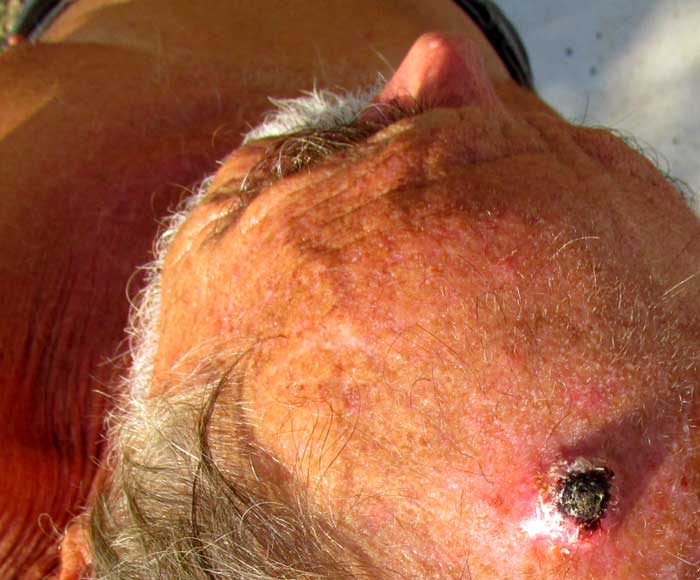Excerpts from Jim Conrad's
Naturalist Newsletter
Issued on September 20, 2020, from northern Uvalde County, southwestern Texas
RICKETTSIALPOX

This entry is for readers in the Yucatan who spend time in the countryside, especially where there are house mice, as I have for the last six years.
About 6 weeks ago, as I was ending my stay of over a year in the stone hut in the woods outside Tepakán, Yucatan, I had a rough-feeling rash atop my head. A week later, upon my arrival in southwestern Texas, the rash had developed into a small, boil-like bump, and a week later the bump had the black scab shown above.
Note that the bump is volcano-shaped, with the scab sunken a little below the crater's rim, and silvery scales of dead epidermis appear on the swollen, reddened rim. These are exactly the features of items that two years ago were surgically removed from my back and upper arm by a doctor in Valladolid, who called the items fleshy tumors, 60% chance cancerous.
These bumps are similar to lesions caused by skin cancer. However, skin cancers I've seen on the Internet don't produce black scabs sunken in a crater of reddish, swollen tissue like this. Also, I don't believe they form as fast as this lesion did. Viewing many such lesions using the Google image search feature, I found some exactly like mine. They were associated with infections of Rickettsia bacteria, and closely related to Rocky Mountain Spotted Fever, transmitted by ticks. The bumps with their scabs are called "eschars."
I can find two eschar-producing Rickettsial diseases known to occur in the Yucatan, though neither seem much recognized beyond the technical literature. Certainly my surgeon in Valladolid didn't know about Rickettsia eschars. Several cases caused by RICKETTSIA PARKERI RICKETTSIOSIS have been documented in the Yucatan, and at a hospital in Mérida a Maya child died from it. Symptoms include fever, headache, a rash over the body and muscle aches, all severe.
The other eschar-producing Rickettsial disease known in the Yucatan is called "Rickettsialpox," and is caused by RICKETTSIA AKARI. I think I have that, mainly on the grounds that my symptoms have been much less severe than those described for the former one. This disease is transmitted by the house mouse mite, and that mite must be common in the Yucatan backcountry because of the two eschars I got in the woods near Ek Balam, and this one from near Tepakán.
I read that the antibiotic Doxycycline controls the disease if administered in early stages. Here I have gone without medication since a prescription is required, and I have had bad experiences with northern doctors confronted with diseases they don't know. Once you enter the door it's a rabbit hole of lab fees, called-in experts and misdiagnoses.
At this date I have few or no symptoms and my eschar is much reduced. I don't like using antibiotics for ethical reasons (growing resistance of bacteria because of overuse of antibiotics), plus I read that the disease is "self-limited," and generally benign, and that it's rare for a patient to develop complications and death.
It's not contagious. If you get such an eschar in the Yucatan, get treatment there instead of returning north. The doctor probably won't know anything about it, but if you provide the above information I think they'll understand and treat it.
You can read about this disease at https://www.ncbi.nlm.nih.gov/books/NBK448081/.